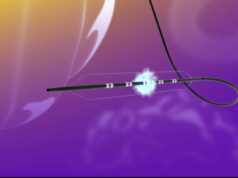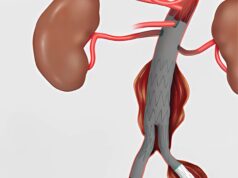By Thomas Wyss
Current trends in vascular imaging were presented on 22 January 2010 at the Controverses et Actualités en Chirurgie Vascularie (CACVS) meeting in Paris, France.
Hicham Kobeiter of the Henri Mondor Hospital in Créteil, France showed the potential of three-dimensional angiography using different techniques. A rotational C-arm is operated to create a synchronised combination of fluoroscopy and angiography. Hereby a dynamic three-dimensional roadmap is constructed in the angio suite. Automated synchronisation of table position, image magnification and C-arm angulation results in data sets with high matching accuracy. The combination of three-dimensional angiography and computed tomography-like images allows for fast visualisation of the vessels as well as the surrounding tissue in one image without leaving the angio suite. Assessment of soft tissue and bones in three-dimensional relation to the vascular anatomy becomes practicable. Therefore real-time reconstruction and immediate continuation of the endovascular or open intervention are attainable. Planning of endovascular procedures and the actual intervention itself are supported by these means. Complex vascular anatomy can be visualised better. Kobeiter shows promising cases of embolisation of endoleaks after endovascular aneurysm repair or planning of a stent placement to exclude a false aneurysm using these depicted techniques.
Antoine Lucas of the Pontchaillou Hospital in Rennes, France continued the imaging session highlighting the benefit of reconstruction and analysis software in the angio suite and operating theatre. The discrepancy between accurate pre-operative information available nowadays with computed tomography scans on one side and the poor imaging information (fluoroscopy) available whilst in the operating theatre on the other side is a drawback. Basically, three stages of computer-aided endovascular surgery are examined: sizing, planning and intra-operative assistance. Three-dimensional software can help in sizing of endovascular interventions to perfectly assess the patient’s anatomy. In the next step, patient-specific training can be performed: choice of intra-operative C-arm pose, simulation of catheterisation based on actual patients and steering of catheterisation robots. In the third step, three-dimensional intra-operative visualisation of the vessel wall, calcified plaques and thrombus is possible in real-time with full integration in a standard operating theatre. Enhanced visualisation could improve the long-term performance of the intervention and reduce radiation and contrast medium usage.
Anne Long from Reims, France covered the third part of the session, addressing the question whether three-dimensional duplex scan for vascular applications is a leap forward. Again, volume calculations are a pivotal feature in three-dimensional imaging. Volume is obtained by juxtaposition of two-dimensional slices using two-dimensional probes. Three-dimensional probes offer direct and instantaneous volume acquisition, with higher image quality and less artefacts than two-dimensional probes. Semi-automatic contouring tools for detection of the wall help in the assessment of complex volumes. However, ECG-gating, in order to reduce pulsation artefacts, has so far not been introduced. Computerised measurement tools then perform distance and volume calculations. Nowadays, two-dimensional ultrasound is used for screening and growth-surveillance of abdominal aortic aneurysms. Long hypothesises, that maybe in the future, post-endovascular repair follow-up will be guided by volume measurements, instead of diameter measurements, using three-dimensional duplex ultrasound.
Three-dimensional imaging has considerable visualisation enhancements and reduces parallax error. This contributes to a significant raise in accuracy of the anatomical assessment. Availability of the above explained techniques in the angio suite and operating theatre is key for real-time implementation. As a consequence, dynamic real-time three-dimensional imaging may lead to better patient selection and improved peri-procedural planning and interventional technique.












